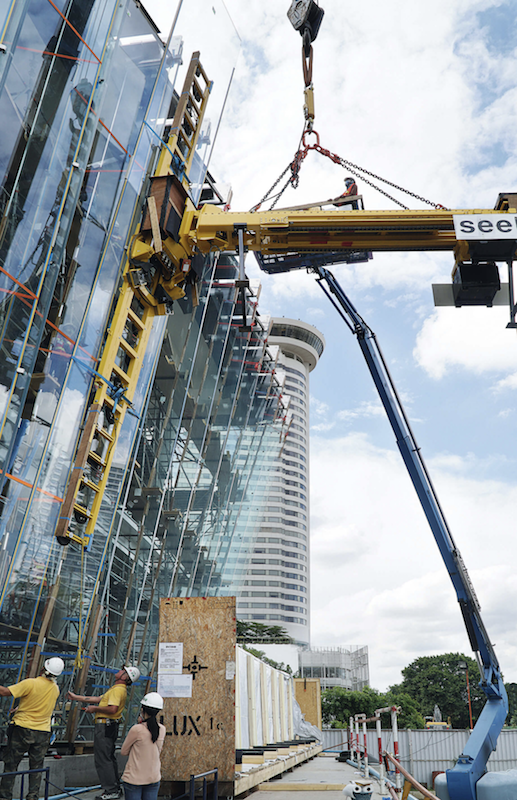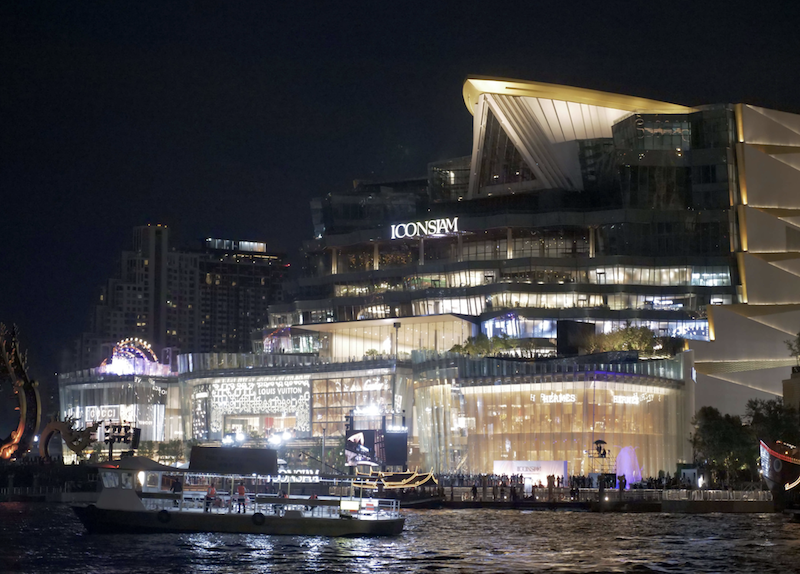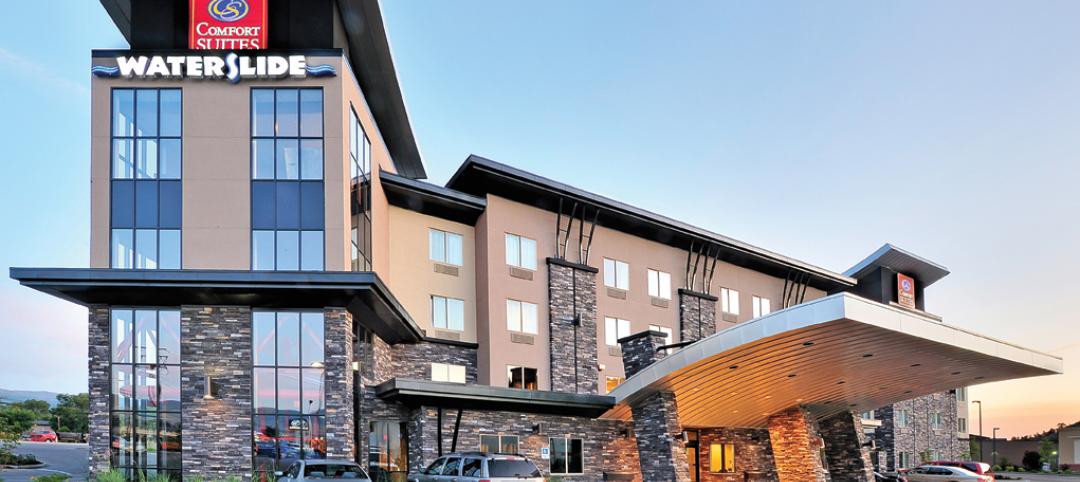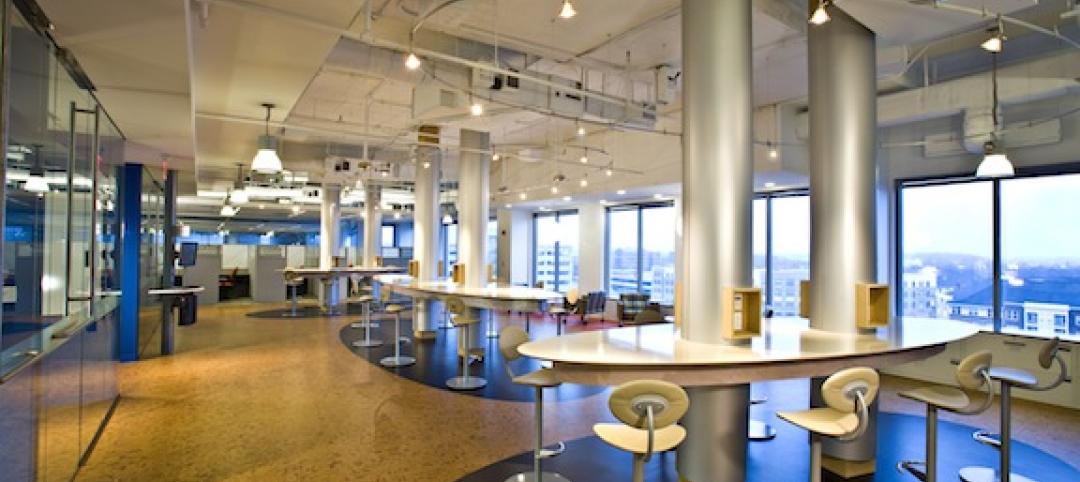When it opened along the Chao Phraya River in Bangkok, Thailand, on Nov. 10, the massive luxury shopping mall Iconsiam—self-identified as “the Icon of Eternal Prosperity”—boasted a number of firsts, including the longest (400-plus meters) water feature in Southeast Asia, and the first project in the country to integrate road, rail, and water transportation. (The complex is 1 kilometer from a station for the BTS Skyway monorail that will be completed next year.)
This 750,000-sm (8.072-million-sf) mixed-use complex, with 525,000 sm of retail space over 10 floors, is connected to Thailand’s first Apple store (and the largest in Asia), and also features a 10,000-sm River Park, a 3,000-seat auditorium, the National Treasure Museum, and two condo towers.
The complex, which cost 54 billion Thai baht to complete (the equivalent of US$1.67 billion, based on today’s currency exchange rate), is being positioned as a regional destination attraction. Its owners—the retail developer Siam Piwat, the conglomerate Charoen Pokphand Group, and MQDC Magnolia Quality Development—reportedly spent at least 1 billion baht promoting its complex’s debut, which included an opening-night performance by Alicia Keys and a red-carpet parade whose celebrities included the actress Naomi Watts.
But Iconsiam is more than just glitz and one-upmanship. From an engineering standpoint, it is distinguished by a pillarless suspended all-glass façade that is among the world’s longest: 300 meters long, up to 24 meters high, and having a surface area of 5,300 sm.
Iconsiam’s designer, Urban Architects, specified a pleated arrangement of glass panes that recalls local values and beliefs tied to the river, including “krathong” (a floating, folded sculpture) and “baisri” (the art of traditional flower arrangement with folded leaves.)

Installation of the glass panel assembly was achieved with a specially manufactured suction unit that allowed crews to position the panes into different angles. Image: Seele
To create this effect, the project’s building team, which included the façade construction specialist Seele, devised a special large-format (up to 25.6 sm for one piece), high-precision glass component weighing up to 3.5 tons per pane.
The façade is comprised of 333 glass panes that are supported by an equal number of 8- and 16-meters-long glass “fins.” The heat-strengthened glass used for the façade, known as TVG, was produced by Sedak. (This process cools the glass at a slower intensity, thereby producing compressive stresses that increase the glass’s strength.)
Seele produced the fins and stainless steel “shoes” for the façade off site at one of its locations in Germany.
The weight of the panes is absorbed at their lower end by transoms. Steel components connected directly to the glass were designed as bolted connections to eliminate losses in accuracy from welding distortion.
To install the façade assembly, Seele specifically developed for this project an apparatus with two suction units with counterweight and three-axial adjustment, which made it possible to lift the glass into its double-inclined position. (The glass fins have a 12-degree angle of inclination from the vertical. The inclination of the façade’s overhang is between 0 and 14 degrees.)
During the installation, custom-wood supports that formed the façade’s contour were used to temporarily stabilize the fins.
Thomas Spitzer, Managing Director of Se-Austria, a company within Seele, said in a prepared statement that the Building Team was able to complete the façade’s construction in under two years because the engineering and production were provided by a single source. “Iconsiam is a unique project for us,” he said.
Related Stories
| Mar 8, 2011
ThyssenKrupp Nirosta, Christian Pohl GmbH supply stainless steel to One World Trade Center
Corners of the One World Trade Center 's facade will be edged with stainless steel made in Germany. ThyssenKrupp Nirosta (Krefeld) produced the material at its Dillenburg plant using a customized rolling and heat-treatment process. Partner company Christian Pohl GmbH (Cologne) fabricated the material into complex facade elements for the corners of the New York City skyscraper.
| Feb 11, 2011
Four Products That Stand Up to Hurricanes
What do a panelized wall system, a newly developed roof hatch, spray polyurethane foam, and a custom-made curtain wall have in common? They’ve been extensively researched and tested for their ability to take abuse from the likes of Hurricane Katrina.
| Feb 9, 2011
Kingspan Insulated Panels Announces Path to NetZero Mobile App
Kingspan Insulated Panels North America, a global manufacturer of insulated metal panels, announces the availability of its new Path to NetZero mobile app. Introduced at Greenbuild 2010, this unique tool for the building industry simulates the process of achieving high-performance and net-zero buildings.
| Jan 4, 2011
Product of the Week: Zinc cladding helps border crossing blend in with surroundings
Zinc panels provide natural-looking, durable cladding for an administrative building and toll canopies at the newly expanded Queenstown Plaza U.S.-Canada border crossing at the Niagara Gorge. Toronto’s Moriyama & Teshima Architects chose the zinc alloy panels for their ability to blend with the structures’ scenic surroundings, as well as for their low maintenance and sustainable qualities. The structures incorporate 14,000 sf of Rheinzink’s branded Angled Standing Seam and Reveal Panels in graphite gray.
| Dec 17, 2010
Gemstone-inspired design earns India’s first LEED Gold for a hotel
The Park Hotel Hyderabad in Hyderabad, India, was designed by Skidmore, Owings & Merrill to combine inspirations from the region’s jewelry-making traditions with sustainable elements.
| Dec 17, 2010
Cladding Do’s and Don’ts
A veteran structural engineer offers expert advice on how to avoid problems with stone cladding and glass/aluminum cladding systems.
| Dec 7, 2010
Product of the Week: Petersen Aluminum’s column covers used in IBM’S new offices
IBM’s new offices at Dulles Station West in Herndon, Va., utilized Petersen’s PAC-1000 F Flush Series column covers. The columns are within the office’s Mobility Area, which is designed for a mobile workforce looking for quick in-and-out work space. The majority of workspaces in the office are unassigned and intended to be used on a temporary basis.














